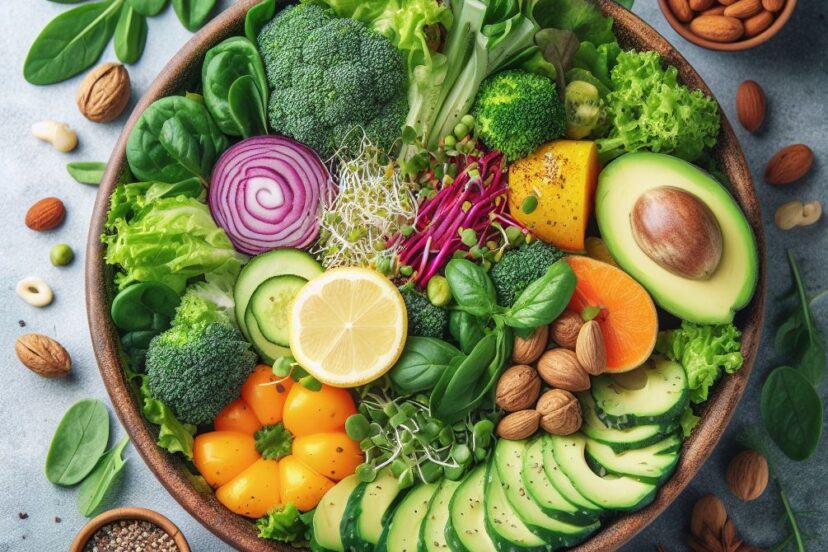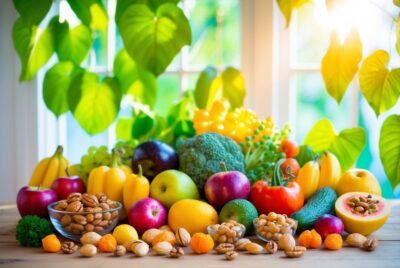Candida Diet Recipes: Your Path to Better Health
*We may earn a commission for purchases made using our links. Please see our disclosure to learn more.
Candida Diet Recipes: Simple and Delicious Meals for Gut Health
Today I share some of my favorite Candida Diet Recipes and how to get started! Embarking on a candida diet entails adopting a tailored nutrition plan designed to combat Candida overgrowth—a common condition where the naturally occurring fungus in our bodies proliferates beyond its healthy limits. This can lead to a range of symptoms, including bloating, fatigue, and brain fog, signaling a disruption in the delicate balance of our gut microbiome. As someone who understands the importance of gut health, I recognize that a diet low in sugars and inflammatory foods is critical because these are the fuels that Candida thrives on.

The cornerstone of managing Candida overgrowth through diet involves a thoughtful selection of foods that bolster the immune system and gastrointestinal health while starving the yeast-like fungus of its preferred nutrients. This means that the candida diet recipes I adhere to are rich in vegetables, high-quality protein sources, and healthy fats. These ingredients are crucial for a meal plan that is not only effective in combating overgrowth but is also sustainable and nutritionally balanced.
Consequently, devising a diet around these guidelines requires one to be meticulous and informed about the ingredients and preparation methods. For those new to this diet, it can seem restrictive at first glance, but with the right recipes and food choices, it is quite possible to create satisfying meals that support healing and well-being. It is not merely about exclusion, but about nurturing the body with the right kind of sustenance that promotes a harmonious internal environment where Candida can exist without overstepping its bounds.
Understanding Candida Overgrowth

As a critical component of a balanced microbiome, Candida is a yeast that normally lives harmlessly in small amounts within our bodies. However, overgrowth can disrupt well-being, leading to a range of unwanted symptoms and health issues.
Symptoms and Causes
The occurrence of Candida overgrowth is often marked by distinctive symptoms. These can range from digestive issues to fatigue, skin infections, and immune system challenges. Common signs include:
- Oral thrush
- Genital yeast infections
- Gut dysbiosis
- Skin and nail fungal infections
The primary causes of overgrowth are multifaceted. They include:
- Antibiotic use: which can reduce the population of beneficial bacteria in the gut, allowing Candida to multiply unchecked.
- Compromised immune function: which can occur due to illness or stress, providing Candida with the opportunity to grow more rapidly.
- High-sugar diets: that fuel yeast growth.
- Excessive alcohol intake: which may disrupt gut flora.
- Excessive stress: leading to inflammation and weakened immunity.
The Role of Diet in Managing Candida
My dietary choices play a pivotal role in managing and preventing Candida overgrowth. Adhering to a diet low in sugars and refined carbohydrates is essential since these foods can promote yeast growth. Candida-friendly diets often focus on:
- Non-starchy vegetables: which provide vital nutrients without feeding the overgrowth.
- Lean proteins: essential for maintaining muscle and supporting immune function.
- Healthy fats: which can reduce inflammation.
- Probiotic foods: to restore and maintain a healthy gut microbiome.
By eliminating foods that exacerbate yeast growth and consuming those that support a healthy immune system, I can help keep Candida levels in check. This dietary strategy is not only about subtraction; it includes adding nutrient-dense, anti-inflammatory foods that support my overall health.
Foundation of the Candida Diet

The Candida Diet focuses on reducing the intake of foods that can feed Candida yeast, while promoting a nutrient-rich environment that discourages Candida overgrowth. I’ll guide you through which foods you should include and which to avoid, keeping in mind the balance of whole foods, healthy fats, non-starchy vegetables, and quality proteins.
Foods to Include
Whole Foods: I prioritize unprocessed, whole foods to ensure a diet rich in nutrients without added sugars that can contribute to Candida growth.
Healthy Fats: Incorporating sources of healthy fats is crucial for maintaining energy and supporting overall health. Here is a list for reference:
- Avocado
- Extra virgin olive oil
- Coconut oil
- Flaxseed oil
- Walnuts
Non-Starchy Vegetables: Non-starchy vegetables are low in carbohydrates and help to maintain a balanced sugar level. My diet includes:
- Asparagus
- Broccoli
- Brussels sprouts
- Cabbage
- Kale
- Spinach
Proteins: Adequate protein intake supports immune function and tissue repair. I focus on:
- Wild-caught fish
- Organic chicken
- Turkey
- Eggs
- Hemp seeds
- Pea protein
Foods to Avoid
Sugar: I eliminate all forms of added sugars, as they can feed Candida, and even limit high-sugar fruits.
Gluten: Due to its inflammatory potential, I avoid gluten-containing grains and opt for non-glutenous alternatives like quinoa and buckwheat.
Dairy: Most dairy products are on my “avoid” list because of the lactose content, which can be a sugar source for Candida.
Alcohol: It’s important for me to avoid alcohol because it can weaken the immune system and also act as a sugar source for yeast.
By adhering to these guidelines, I’m creating a dietary environment that is less favorable for Candida overgrowth and more conducive to overall health and balance.
Candida Diet Meal Planning

When formulating a meal plan for a Candida diet, my goal is to create satisfying meals that support gut health and help manage Candida overgrowth. This means focusing on low-sugar, non-glutenous grains, high-quality proteins, and plenty of fresh vegetables, while avoiding added sugars, dairy, and caffeine.
Breakfast Recipes
For breakfast, I prioritize options that are satisfying and energizing, without relying on added sugars or gluten. Here’s a typical breakfast recipe:
- Gluten-Free, Dairy-Free Protein Pancakes:
- Ingredients:
- 1/2 cup almond flour
- 2 eggs
- 1/4 cup water or a dairy-free milk substitute
- 1 tsp. baking powder
- A pinch of salt
- Optional: cinnamon or vanilla extract for flavor
- Directions:
- Whisk together all ingredients until a batter forms.
- Pour small rounds onto a heated, non-stick pan.
- Cook until bubbles form, then flip and cook until golden brown.
- Serve with a topping of fresh strawberries.
- Ingredients:
Lunch Ideas
Lunch is an opportunity to incorporate a variety of vegetables and lean proteins to stay aligned with the Candida diet guidelines:
- Chicken Salad:
- Ingredients:
- 1 grilled, skinless chicken breast (diced)
- Mixed greens (spinach, arugula, kale)
- 1/4 cucumber, sliced
- 1/4 red bell pepper, diced
- A small handful of almonds
- Olive oil and lemon juice for dressing
- Directions:
- Toss the diced chicken breast with the mixed greens, cucumber, and red bell pepper.
- Sprinkle almonds on top for added crunch.
- Dress the salad with olive oil and freshly squeezed lemon juice.
- Ingredients:
Dinner Options
Dinner on the Candida diet can be hearty and fulfilling. Here’s a sample dinner recipe that adheres to the diet’s requirements:
- Quinoa Stuffed Bell Peppers:
- Ingredients:
- 2 large bell peppers, halved and seeds removed
- 1 cup cooked quinoa
- 1/2 cup diced tomatoes
- 1/4 cup diced onions
- 1 clove garlic, minced
- 1/2 cup black beans (optional, for added protein)
- Spices as desired (e.g., cumin, paprika, salt, and pepper)
- Directions:
- Preheat the oven to 375°F (190°C).
- Mix the quinoa with tomatoes, onions, garlic, black beans, and spices.
- Stuff the bell pepper halves with the quinoa mixture.
- Place in a baking dish and bake for 25-30 minutes, until the peppers are tender.
- Ingredients:
By focusing on these types of meals, individuals can adhere to a Candida diet while enjoying a wide range of nutrients and flavors.
Supporting Your Diet with Lifestyle Changes

As I focus on rebuilding my gut health through the Candida Diet, it’s crucial for me to acknowledge that what I consume is just one piece of the puzzle. Pairing dietary efforts with appropriate lifestyle adjustments can significantly amplify the benefits of the cleanse. Addressing both stress and sleep, as well as considering supplemental support, form key components of a comprehensive approach to managing Candida.
Addressing Stress and Sleep
Stress directly impacts my digestion and can hinder the effectiveness of the Candida cleanse. By managing stress through techniques such as meditation, deep breathing exercises, and yoga, I support my body’s ability to heal. Sleep is equally important, as it allows my gut to repair and strengthen overnight. I aim for 7-9 hours of quality sleep per night, establishing a regular sleep routine to ensure I’m giving my body the rest it needs.
- Stress-Reduction Techniques:
- Meditation: 10-20 minutes daily
- Yoga: 3 times per week
- Deep Breathing: 5 minutes twice daily
- Sleep Optimization Practices:
- Consistent bedtime schedule
- Sleep-friendly environment (dark, cool, and quiet)
- Limiting screen time before bed
Supplemental Support
Incorporating supplements that promote gut health can be beneficial alongside the Candida Diet. I take a probiotic to help restore the balance of healthy bacteria in my gut. Additionally, antifungal supplements may assist in combatting Candida directly. I always consult with a healthcare provider before adding new supplements to my routine to ensure they align with my health goals and current regimen.
- Helpful Supplements:
- Probiotics: 1 daily dose
- Antifungals: As recommended by healthcare provider
By managing my stress levels and prioritizing sleep, and with the help of carefully chosen supplements, I support my body’s natural ability to cleanse and combat chronic fatigue associated with Candida overgrowth. This combined approach helps to optimize my digestion and overall gut health.
Delicious Candida-Friendly Recipes

Candida diet adherents often experience a need for variety while maintaining strict dietary guidelines. My compilation here focuses on recipes that are both satisfying to the palate and compliant with Candida diet principles.
Satisfying Entrees
Grilled Lemon and Herb Salmon
- I combine lemon zest and a touch of olive oil to marinate salmon fillets. After marinating for at least an hour, I grill them until flaky.
- Salmon not only provides the needed protein but also the omega-3 fatty acids beneficial for overall health.
Spiced Ground Turkey with Steamed Asparagus
- Utilizing turkey as a lean protein source, I flavor it with allowable spices like cumin and turmeric. I serve it alongside steamed asparagus, ensuring a nutritious, balanced meal.
Refreshing Salads
Kale and Avocado Salad with Lemon Dressing
- For a fresh and vibrant salad, I massage curly kale with a lemon and coconut oil dressing. I then top with slices of avocado for healthy fats.
- The addition of grilled chicken or turkey is a great balance for those desiring added protein.
Creative Snacks and Sides
Candida Diet Soup
- A vegetable broth-based soup with a medley of Candida-friendly vegetables like zucchini, celery, and spinach is one of my staples. I often season it with a pinch of Himalayan salt and a sprinkle of cinnamon for added depth.
Coconut Cinnamon Energy Balls
- I process together unsweetened coconut flakes, a hint of cinnamon, and stevia for sweetness, forming the mixture into bite-sized energy balls.
- These make for a convenient, satisfying snack that complies with the Candida diet restrictions.
Navigating Challenges and Considerations
In my journey through the Candida diet, I’ve encountered a few sticking points that require a directed approach, especially cravings and navigating social situations.
Dealing with Cravings
I find that cravings are often the first challenge to surface when beginning the Candida diet. Sugar, a primary source of nourishment for Candida yeast, must be eliminated, making cravings for sweets quite common. To counter this, I opt for natural sweeteners like stevia. Unlike artificial sweeteners and sugar, stevia doesn’t feed Candida and has no calories, which helps in managing insulin levels too.
It’s also crucial for me to stay hydrated by drinking plenty of water, which can sometimes reduce cravings. I also include apple cider vinegar in my diet; it aids digestion and is known for its ability to help balance my body’s pH levels, potentially reducing cravings as well.
Eating Out and Social Situations
Dining out can be tricky on the Candida diet since alcohol, sugar, most sweeteners, and caffeine are usually on the ‘avoid’ list. My solution is to always plan ahead. If I’m going to a restaurant, I preview the menu online and choose options that align with my diet, such as salads without dressings (since many contain sugar or vinegar) or grilled protein with steamed vegetables.
Socially, I’ve learned transparency about my dietary restrictions is best. If I’m a guest, I offer to bring a Candida-friendly dish that everyone can enjoy. This ensures that I have something to eat and it’s a great way to introduce others to the diet. For beverages, I stick to water or herbal teas, clearly steering away from caffeinated and fermented options.
Frequently Asked Questions
The Candida diet is designed to reduce inflammation and the presence of Candida albicans in the body. Here, I answer some common queries about meal planning and recipe options that adhere to this dietary regimen.
1. What are some breakfast options suitable for the Candida diet?
For breakfast on the Candida diet, my go-to choices are often based on low-carb ingredients. I enjoy gut-healing pancakes made from coconut flour, which are free from gluten, nuts, and dairy. They can be paired with a side of non-starchy vegetables or a portion of avocado to add healthy fats.
2. How can I create a Candida diet-friendly meal plan?
In creating a meal plan, I ensure it’s rich in vegetables, low-sugar fruits, non-glutenous grains, and probiotic foods. I recommend planning meals that are high in protein and healthy fats to help maintain satiety throughout the day, with a daily carbohydrate limit of 60 grams.
3. Which desserts can I enjoy while following the Candida diet?
For dessert, I often turn to recipes that use low-carb and low-sugar ingredients. Favorites include Coconut Crisps and Almond Butter Balls made with stevia or erythritol as sweeteners. These options satisfy my sweet cravings without feeding the Candida.
4. Are there simple recipes that adhere to the guidelines of the Candida diet?
Yes, many Candida diet recipes are simple and require few ingredients. A common dish I make is a cauliflower rice stirred with leafy greens and garlic, seasoned with herbs for flavor without the need for sugary or high-carb sauces.
5. Can you recommend dinner recipes that are compatible with the Candida diet stages?
For dinner, I opt for lean protein sources like grilled chicken or baked wild-caught salmon. I pair these with a side of roasted non-starchy vegetables like Brussels sprouts or asparagus, ensuring I get the nutrients needed without straying from the diet’s guidelines.




